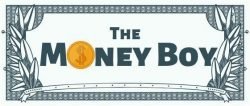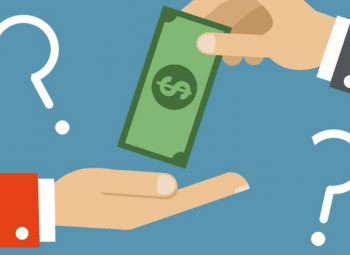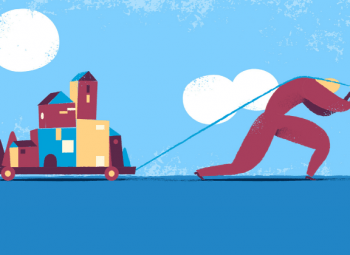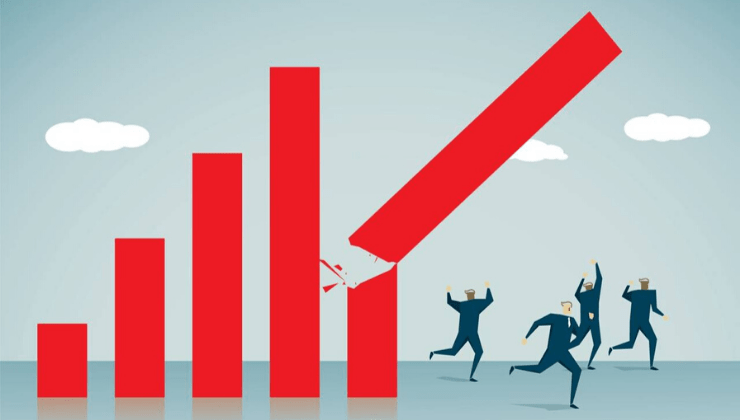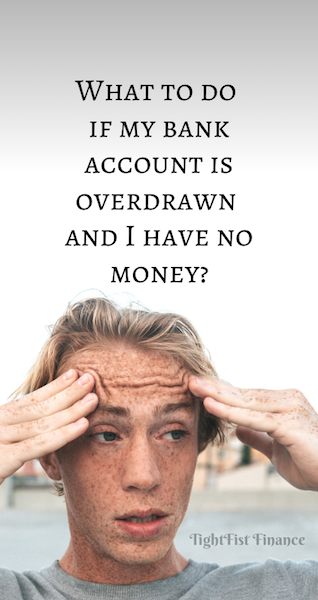
We all make mistakes with our finances at some point. You start with a well-planned budget at the beginning of the month and end up spending more than what you should have. Before you know it, you’ve already overdrawn your bank account and find yourself in deep trouble.
You may find yourself asking: “my bank account is overdrawn and I have no money! What do I do?” The truth is, you’re not alone.
In a given year, 30% of consumers overdraw their checking account, resulting in a median charge of $34[1]. Overdraft and Non-Sufficient funds (NSF) fees constitute the biggest single cost for consumers who own checking accounts.
Just in 2018, banks in the US have raked in around $34.5 billion[2] from these fees. The good news in all this? There are quite a few things you can do about it.
Before we get into those, let’s first unpack what an overdraft fee is.
What is an overdraft fee?
Also known as Non-Sufficient Funds (NSF), an overdraft happens when a customer authorizes a transaction within their account that causes them to go over their current balance.
Some of the most common causes of overdrafts include ATM withdrawals, debit card transactions, paper checks and automated bill payments.
When this happens, the bank has two different routes it can take: 1) the bank can automatically decline the transaction, 2) the bank can allow the transaction through the use of “overdraft protection,” resulting in an overdraft, as well as overdraft fees for the individual.
It is important to note that a bank will usually only allow overdrafts to occur if you have opted in to “overdraft protection,” as it is now illegal for banks to automatically enroll customers without their consent.
With that said, overdrafts without overdraft protection may still occur if pre-approved transactions come through, such as an automatic monthly payment or checks[3].
Even with a steady income, it is important to regularly check in on your checking accounts for overdrafts.
Overdraft fees can add up quickly, with the average “overdraft event” running the consumer over by $69, according to The Pew Charitable Trusts. That is not including the extra fee the bank will charge for providing you “overdraft protection.”
If you think about it, overdrawing your account is similar to taking out a short-term loan, but with a very high interest rate of at least 5000%. For a mistake that can be avoided with simple vigilance and awareness, that is quite a lot of money to lose!
Overdraft Fees by Bank
| Financial institution | Overdraft fee (per item) | Overdraft Protection Transfer fee |
|---|---|---|
| Alliant Credit Union | $28 | $0 |
| Ally Bank | $25 | $0 |
| Bank of America | $35 | $12 |
| Capital One 360 | $35 | $0 |
| Charles Schwab | No Overdraft. $25 NSF fee | $0 |
| Chase | $34 | $10 |
| Citibank | $34 | $10 |
| Citizens Bank | $37 | $12 |
| Discover Bank | $30 | $0 |
| Fifth Third Bank | $37 | $12 |
| Navy Federal Credit Union | $20 | $0 |
| PNC Bank | $36 | $10 |
| Regions Bank | $36 | $15 |
| SunTrust | $36 | $12.50 |
| TD Bank | $35 | $3 (may vary by state) |
| Union Bank | $33 | $10 |
| USAA | $29 | $0 |
| U.S. Bank | $36 | $12.50 |
| Wells Fargo | $35 | $12.50 |
What are the types of overdraft fees?
While overdraft fees are generally the same, some banks will have different rules depending on when a fee is charged and how it was charged to your account.
This is why you’ll probably see different names for fees on your statement, which may cause some confusion. Here are the four most common types of overdraft fees.
1. Overdraft fee
As defined earlier, the overdraft fee is simply the amount charged by a bank every time it processes a transaction that goes over your available balance. Most banks will not charge an overdraft fee if you went over by less than $5.
2. Overdraft Protection transfer fee
An overdraft transfer fee is charged to a customer when a bank transfers money over from one of your linked accounts to cover overdraft transactions.
Even though you may have money in another account to cover the actual overdraft, the bank will still charge you a fee for transferring the money between accounts.
The typical fee can range, as some banks do not charge this fee, while others charge up to around $12 per transfer.
3. Non-Sufficient Funds fee
This fee is charged every time a bank rejects a transaction that would overdraft your account.
This could happen if you have not opted in to Overdraft Protection and don’t have funds in your account to cover a purchase. That’s when you incur a NSF fee.
Typically, you either get charged for Non-Sufficient Funds or overdrafts of your account, but never both.
4. Extended overdraft fee
Also called a “sustained overdraft” or “extended overdrawn balance” fee, this fee is charged when you fail to take action when over drafted for at least 5 business days or 7 calendar days, in most cases.
It is in your best interest to pay overdrafts and their fees as quickly as you can, as delaying payments will only bring more fees.
What to do when your Bank Account is Overdrawn
If you’ve already overdrawn your account, here are some of the most important steps that you should follow:
1. Refrain from making purchases using the account
Once you’ve overdrawn your account, stop using it right away until it is back on track. That means putting off any non-essential spending using your checking account and temporarily stopping all automatic bill payments and subscriptions to avoid incurring more charges and fees.
Once your bank has reached negative, every purchase you make with the account will bring along its own fees. These add up quicker than you think.
2. Bring your account balance into positive quickly
Your bank will typically give you a few days to settle your balance and bring it back to positive before charging extra late fees[4].
Therefore, it is time to act quickly. If you have money in other accounts or you’re getting paid soon, use it to pay off the deficit.
If you are short in funds, consider selling items that you don’t need on eBay, craigslist or Facebook marketplace. If possible, reach out to your friends or family who can help lend some money.
There are lots of freelance websites such as Fiverr and Upwork where you can sell your skills to make some quick cash on the side.
If you think you’re a person with no skills (which I don’t buy), make money walking someone’s dog on Rover. There are hundreds of ways to dig yourself out of the hole. You just have to look in the right direction!
When you deposit the money to your checking account, most banks will automatically pay off the overdraft, as well as the fees you may have incurred from the overdraft.
3. Call your bank and ask for fee forgiveness
So you made a mistake and ran your account into the red for the first time. What should you do?
A lot of banks will usually waive the first overdraft fee or returned check fee if you call them and explain your situation to a bank representative.
They will especially be considerate if this is the first fee you incurred for a new account or if it’s the first incidence in the new calendar year.
Be polite with the representative and do not demand your fees to be waived! Remember that any leeway they grant you is out of goodwill and not an obligation.
If you already owe a lot of money and are not able to settle it all in one go, try talking to your bank about setting up a payment plan. A payment plan may allow you to get back on track without having your account closed or incurring more charges. Make sure to pay what is promised to keep your bank’s trust.
4. Pay the fee if you can afford it
If there comes a time when you need to make an important purchase or payment yet you have insufficient funds, it may make sense to overdraft your account in order to meet your needs.
Please note that over-drafting your account for a necessary payment should only be used for emergency situations.
In addition, you should be confident that you can pay both the overdraft fee, as well as bring your account balance back to positive before the extended fees are charged.
Luckily, your credit score will not be affected by overdraft fees if resolved in a timely manner.
However, it’s very important to remember that avoiding overdrafts is still the best option. Even if you can afford to pay overdraft fees, do not use the privilege for non-essential expenses.
How to prevent future overdrafts
After getting your account back on track, try embracing new habits to avoid going through the same trouble again.
1. Opt out of overdraft protection
Like previously defined, overdraft protection allows you to process transactions even if you don’t have sufficient funds, but that comes with a fee.
If you’re like me, you would rather be declined a purchase then be hit with extra fees and charges. Opt out of Overdraft Protection, as it will keep you on budget and help prevent overspending.
2. Set alerts for low balances
Most banks offer low-balance alerts when your account has hit a certain amount. For example, you can set your account to alert you once your balance has gone below $100.
Whatever your low-balance number is, these alerts will help remind you that you are running low on cash and on the verge of over-drafting your account.
3. Check account balance regularly
Aside from low-balance alerts, make it a habit to check your account balance regularly through your online account so you know how much money you still have and keep yourself from going over budget.
This will help you find out where you’re overspending most and allow you to remove any redundant subscriptions that you no longer use or care for.
Start by checking once a day to follow up on purchases that you have made. Be sure to keep track of what is “pending” and what has gone through in order to know your true balance before making a purchase.
4. Link another account to cover overdraft transactions
If you have other accounts like a savings, money market, or second checking, follow your bank’s guidance on how to link them together.
This will allow you more flexibility in avoiding the larger overdraft fees, as your linked accounts will transfer the money you need to remain above $0. While many banks do not charge you for these transfers, some will charge a very small sum.
5. Time bill payments after paydays
Many banks allow you to set up automatic payments for your bills such as electricity, rent, Wifi, etc. that will be charged on the same day every month.
If you choose to set up these auto-payments, make sure to time them after your payday whenever you can to avoid any chance of overdrafts.
Knowing you always have a full account before an automatic bill payment will ease your worry and be one less thing you have to remember every month.
6. Some banks allow overdraft rewind
An “overdraft rewind” is an option available to you where the bank can withdraw the overdraft fee as long as you have a direct deposit scheduled to come in the next day.
For example, if you have a paycheck that is directly deposited into your account every Thursday at 9:00 am, you can use an overdraft rewind if you over drafted the Wednesday before.
It goes without saying that the direct deposit amount must be large enough to cover the owed amount of money in order for this to work out.
Again, it is not recommended to overdraft if avoidable, but you can ask your bank for this feature if you really need it.
A Final Note
At the end of the day, it all boils down to taking responsibility for your spending and monitoring your accounts. By using these steps and methods, the money you save by avoiding overdraft fees can be put towards a savings account or even invested.
And remember, overdrafting your account is not the end of the world! We have all been there at some point in time and it is a problem with an easy fix. With the use of just a few of these simple steps, you will be out of the red in no time!
Article Sources
1. Consumer Finance Protection Bureau. “A Closer Look: Overdraft and the Impact of Opting-In“
2. Moebs Service. “Overdraft Revenue Inches Up in 2018“
3. Consumer Finance Protection Bureau. “You’ve got options when it comes to overdraft“
4. Consumer Finance Protection Bureau. “Know your overdraft options“
